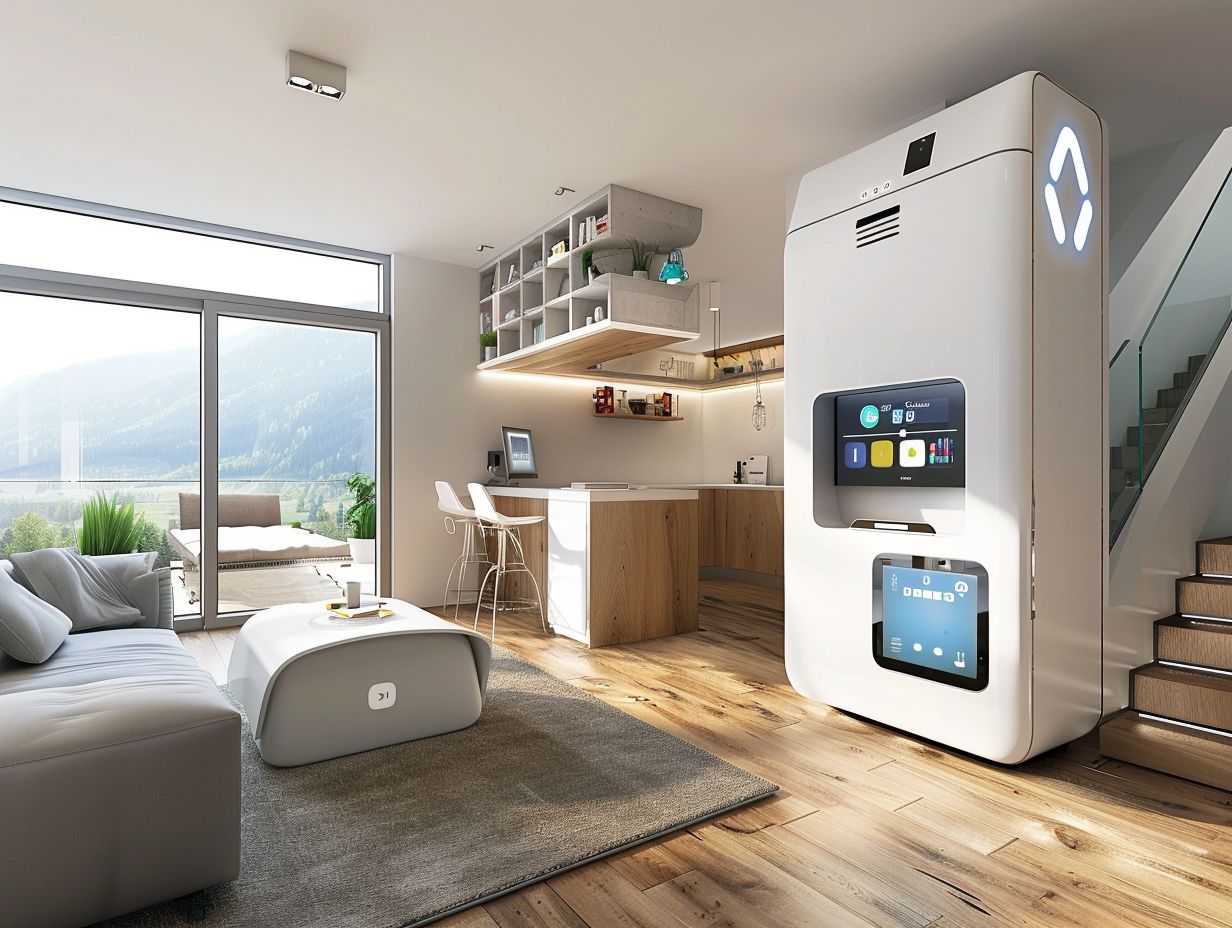
Design Smarter How To Incorporate Iot In Small Space Living
In the contemporary fast-paced environment, the Internet of Things (IoT) is significantly transforming the ways in which individuals live, work, and engage with their surroundings.
For individuals confronted with the challenges of residing in confined spaces, the integration of IoT technologies can yield numerous advantages, ranging from heightened efficiency and convenience to the optimized utilization of restricted areas.
This discourse delves into the potential enhancements that IoT can introduce to small space living, presents illustrative instances of intelligent solutions, deliberates on essential considerations ahead of implementation, and furnishes actionable recommendations for devising a smart small living area.
Prepare to embark on an endeavor to devise more intelligent living spaces, thereby maximizing both spatial utilization and functional attributes within your compact abode.
Understanding the Concept of IoT
The comprehension of the Internet of Things (IoT) concept entails understanding the seamless fusion of technology and innovation to establish efficient and interconnected systems. IoT denotes a network of devices equipped with sensors and software that facilitate communication and data exchange to enhance automation and connectivity.
Through the utilization of IoT technology, various sectors such as healthcare, agriculture, transportation, and smart cities have undergone significant transformations in their operations. The fundamental principle of IoT resides in its capacity to gather and process extensive data in real-time, give the power toing businesses and individuals to make well-informed decisions. From smart thermostats capable of adjusting temperatures based on user preferences to industrial machinery that autonomously detects issues and schedules maintenance, IoT has revolutionized our interaction with technology in our everyday lives.
Challenges of Living in a Small Space
Residing in a confined living area presents individuals with challenges concerning space-saving strategies, optimizing interior layouts, and the necessity for compact living solutions. Those navigating small living spaces frequently encounter limitations when arranging furniture, storing belongings, and establishing a functional yet visually pleasing environment.
One prevalent difficulty experienced by individuals in compact living environments pertains to sourcing multipurpose furniture that can fulfill dual roles without occupying excessive space. Scarce storage options can result in clutter, underscoring the importance of integrating innovative storage solutions, such as leveraging vertical space through shelving or under-bed storage.
Another recurring issue involves striking a balance between aesthetics and functionality, given the complexity of designing a visually appealing space while ensuring it remains practical within a confined setting.
Benefits of Incorporating IoT in Small Space Living
The advantages of integrating IoT in small space living are numerous, encompassing improved efficiency and connectivity, as well as seamless automation solutions specifically designed for limited areas. Through the incorporation of IoT technology, individuals have the capability to convert their living spaces into intelligent, automated centers that enhance functionality while reducing physical footprint.
Efficiency and Convenience
The integration of IoT solutions for small spaces is greatly influenced by the factors of efficiency and convenience. These solutions provide users with intelligent tools that improve connectivity, streamline daily tasks, and offer a user-friendly experience. By utilizing IoT technology, individuals can attain optimal efficiency and convenience in managing their living environment.
The implementation of IoT applications can turn small living spaces into smart environments where various devices communicate seamlessly, automating processes and enhancing overall functionality. These intelligent solutions not only simplify daily routines but also promote energy efficiency and cost savings. Equipped with user-friendly interfaces and remote control capabilities, individuals can conveniently access and manage their connected devices, creating a home that effortlessly adapts to their needs. The convenience facilitated by IoT applications transcends mere automation, fundamentally changing how individuals interact with their living spaces.
Space Optimization
Space optimization in small living areas requires strategic solutions and effective space management techniques to maximize the functionality of every corner. By integrating IoT devices and intelligent design elements, individuals can develop multi-functional spaces that align with their lifestyle needs while ensuring a seamless integration of technology.
This approach not only facilitates a well-organized and clutter-free living environment but also cultivates an aesthetically pleasing ambiance. Innovative storage solutions, such as concealed compartments, modular furniture, and wall-mounted shelves, can assist in decluttering space and fully utilizing the available square footage.
The utilization of versatile furniture pieces that serve dual purposes, such as a sofa bed or a storage coffee table, can enhance the room’s functionality without overcrowding it. Embracing a minimalist mindset and carefully selecting furniture that complements the overall design scheme can further optimize the visual appeal of the space.
Examples of IoT in Small Space Living
Instances of IoT in Small Space Living demonstrate innovative applications, including Smart Home Systems that automate household tasks and Multi-functional Furniture that adjusts to diverse spatial requirements. These sophisticated solutions seamlessly integrate technology with interior design to optimize the effectiveness and convenience of compact living environments.
Smart Home Systems
Smart Home Systems encompass the integration of automation and seamless device integration to provide intelligent solutions for managing various aspects of the living environment. These systems give the power to users to efficiently monitor and control their homes, enhancing convenience and energy-saving capabilities through sophisticated design and technological amalgamation.
By linking devices such as lights, thermostats, and security systems, smart home systems optimize functionality within compact living spaces. The fluid integration allows users to remotely control these devices, adjusting settings with simplicity. This advanced level of automation not only streamlines daily tasks but also contributes to a more comfortable and secure living environment. Leveraging smart solutions like voice commands and behavior analysis, these systems adapt to individual lifestyles, ensuring personalized experiences customized to the specific requirements of the residents.
Multi-functional Furniture
Multi-functional Furniture exemplifies the epitome of space-saving solutions and functional design elements that enrich interior decor while maximizing the available space in compact living environments. By integrating versatile furniture pieces, individuals can establish adaptive living areas that address their diverse needs without compromising on style or functionality.
These furniture pieces present a seamless integration of utility and aesthetics, rendering them ideal for individuals aiming to optimize every square inch of their living space. Ranging from sofa beds that seamlessly convert into sleeping arrangements to coffee tables featuring concealed storage compartments, multi-functional furniture stands as a resourceful solution for residents of small spaces. The adaptability of these pieces enables swift transitions between various functions, adeptly adjusting to evolving requirements throughout the day. Furthermore, in addition to their space-saving advantages, they contribute to a unified interior design by infusing both functionality and elegance into the confined space at hand.
Considerations Before Implementing IoT in a Small Space
Before the implementation of IoT in a limited area, individuals must carefully consider factors such as budget allocations, ongoing maintenance requirements, and the compatibility of IoT solutions with existing efficiency solutions. It is imperative to evaluate the long-term sustainability and advantages of integrating IoT technology within the framework of small space living.
Budget and Maintenance
The effective management of budget and maintenance aspects in IoT implementations within limited spaces is essential for ensuring the long-term sustainability and efficacy of automated systems. Through meticulous financial planning and proactive maintenance strategies, individuals can maximize the benefits derived from their IoT investments while upholding operational efficiency.
This strategic approach not only aids in optimizing the allocation of resources but also facilitates the seamless integration of IoT solutions into the living environment. Sustainable practices are pivotal in guaranteeing that automated systems in confined spaces operate efficiently and with minimal environmental impact. By incorporating energy-efficient technologies and adhering to regular maintenance protocols, individuals can establish a harmonious equilibrium between technological progress and environmental stewardship. Ultimately, the objective is to develop intelligent living spaces that are not only convenient but also sustainable in the enduring sense.
How to Design a Smart Small Space
Creating an intelligent small space entails meticulous planning for the seamless integration of technology, effective space utilization, and visually appealing interior design elements. The inclusion of IoT technology and cutting-edge solutions enables individuals to establish practical living spaces that embody contemporary design principles and cater to their technologically adept lifestyle.
Tips and Tricks for Maximizing Space and Functionality
Achieving optimal space utilization and functionality in limited living areas necessitates the implementation of efficient solutions, strategic space layout optimization, and the alignment of design elements with the occupant’s lifestyle preferences. By integrating intelligent design choices and practical recommendations, individuals can metamorphose their compact living spaces into personalized sanctuaries that emphasize both functionality and aesthetic appeal.
The inclusion of multi-functional furniture pieces can prove transformative in compact living areas. Incorporating items such as murphy beds, fold-out desks, and nesting tables can offer versatility while maintaining a stylish aesthetic. Leveraging vertical space through the incorporation of shelving units and wall-mounted organizers can facilitate decluttering and maximize storage capacity. Customizing the color scheme and lighting arrangements to foster a sense of spaciousness can further augment the perceived expanse of the area. These lifestyle-centric modifications not only enhance the practical utility of the space but also cultivate a visually enticing and cohesive living environment.




No Comments